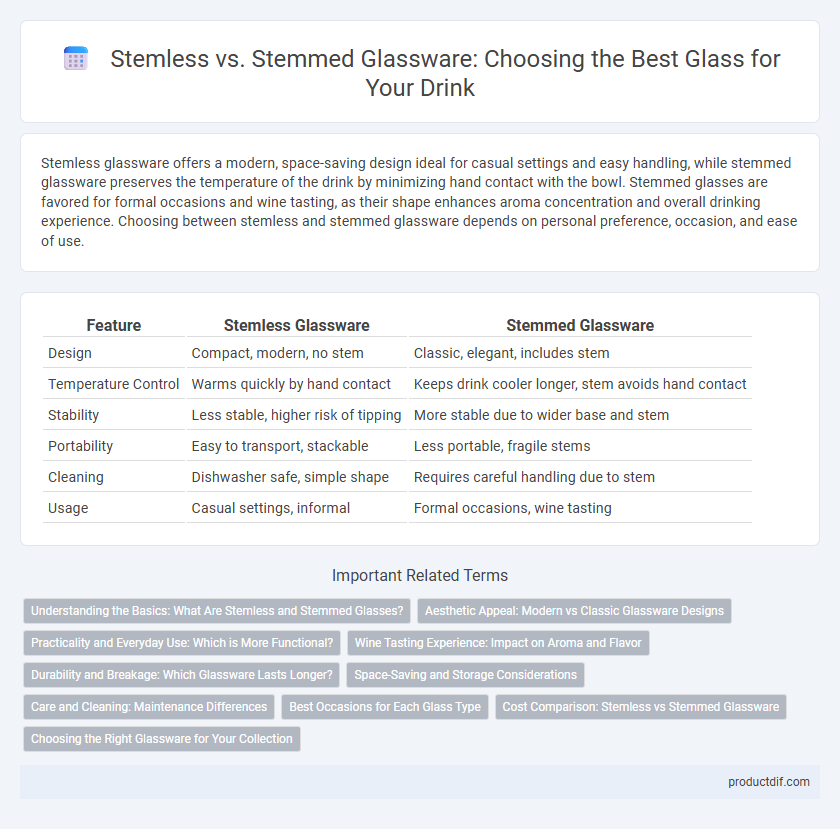Stemless glassware offers a modern, space-saving design ideal for casual settings and easy handling, while stemmed glassware preserves the temperature of the drink by minimizing hand contact with the bowl. Stemmed glasses are favored for formal occasions and wine tasting, as their shape enhances aroma concentration and overall drinking experience. Choosing between stemless and stemmed glassware depends on personal preference, occasion, and ease of use.
Table of Comparison
| Feature | Stemless Glassware | Stemmed Glassware |
|---|---|---|
| Design | Compact, modern, no stem | Classic, elegant, includes stem |
| Temperature Control | Warms quickly by hand contact | Keeps drink cooler longer, stem avoids hand contact |
| Stability | Less stable, higher risk of tipping | More stable due to wider base and stem |
| Portability | Easy to transport, stackable | Less portable, fragile stems |
| Cleaning | Dishwasher safe, simple shape | Requires careful handling due to stem |
| Usage | Casual settings, informal | Formal occasions, wine tasting |
Understanding the Basics: What Are Stemless and Stemmed Glasses?
Stemmed glasses feature a slender stem connecting the bowl to the base, allowing users to hold the glass without warming the contents, which is essential for maintaining optimal temperature and aroma in wines. Stemless glasses lack this stem and have a rounded or tapered bowl that sits directly on the base, offering a modern aesthetic and increased stability but may result in quicker temperature changes. Choosing between stemmed and stemless glassware depends on factors such as wine type, serving temperature, and personal preference for grip and presentation.
Aesthetic Appeal: Modern vs Classic Glassware Designs
Stemless glassware offers a sleek, modern aesthetic with clean lines and minimalist design, perfect for contemporary settings and casual occasions. Stemmed glassware reflects a classic elegance, featuring traditional shapes and delicate stems that enhance the visual appeal and sophistication of formal dining. The choice between stemless and stemmed glasses ultimately influences the ambiance, balancing modern simplicity against timeless refinement.
Practicality and Everyday Use: Which is More Functional?
Stemless glassware offers enhanced practicality for everyday use due to its sturdy base, reducing the risk of tipping and spilling. Stemmed glasses provide better temperature control by preventing heat transfer from hands, ideal for savoring wines at optimal chills. Ultimately, stemless glasses excel in casual settings, while stemmed versions prioritize elegance and precise wine tasting.
Wine Tasting Experience: Impact on Aroma and Flavor
Stemless wine glasses allow aromas to dissipate more quickly due to their open design, which can subtly alter the perception of flavor compared to traditional stemmed glasses. Stemmed glasses preserve temperature better by minimizing hand contact with the bowl, enhancing the wine's aromatic concentration and complexity during tasting. The choice between stemless and stemmed glassware significantly influences the sensory experience, affecting aroma retention and flavor depth for various wine types.
Durability and Breakage: Which Glassware Lasts Longer?
Stemless glassware typically offers greater durability and resistance to breakage due to its lower center of gravity and absence of fragile stems, making it less prone to tipping and snapping. Stemmed glassware, while elegant, features delicate stems that increase the risk of breakage during handling and washing. For long-lasting use, stemless glasses provide a practical advantage in strength and stability over traditional stemmed designs.
Space-Saving and Storage Considerations
Stemless glassware offers significant space-saving advantages, as its compact design allows for easier storage in kitchen cabinets and dishwashers. Stemmed glasses, while elegant, require more vertical space and careful handling to avoid breakage during storage. Choosing stemless options maximizes countertop and shelf space, making them ideal for small kitchens and crowded bars.
Care and Cleaning: Maintenance Differences
Stemless glassware requires simpler care due to its compact design, making it less prone to tipping and breakage during washing, especially in dishwashers. Stemmed glasses, while elegant, demand more cautious handling and hand washing to protect delicate stems and avoid damage. Proper maintenance of stemmed glasses includes drying by the base to prevent stress on the stem and frequent inspection for hairline cracks.
Best Occasions for Each Glass Type
Stemless glassware suits casual settings such as outdoor picnics, informal dinners, and everyday use due to its stability and ease of handling. Stemmed glasses are ideal for formal occasions like wine tastings, elegant dinners, and events where temperature control is crucial, as their design prevents hand warmth from affecting the drink. Selecting between stemmed and stemless glasses depends on the occasion's formality and the desired drinking experience.
Cost Comparison: Stemless vs Stemmed Glassware
Stemless glassware typically costs less than stemmed versions due to simpler manufacturing processes and reduced material usage. Stemmed glasses often carry a premium price driven by intricate designs and the added complexity of their stems. Choosing stemless options provides budget-friendly elegance without sacrificing functionality and style.
Choosing the Right Glassware for Your Collection
Stemless glassware offers a modern, casual appeal with easier storage and reduced risk of breakage, ideal for everyday use and informal settings. Stemmed glasses provide the classic elegance necessary for formal occasions, enhancing aroma and temperature control, especially for wines like reds and whites. Selecting the right glassware depends on your lifestyle, storage space, and wine preferences to create a versatile and functional collection.
Stemless vs Stemmed Infographic

 productdif.com
productdif.com